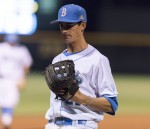John Savage was optimistic.
Leaning back in his chair and signaling toward the wall full of plaques and celebratory photos his program had garnered throughout his tenure at UCLA, the baseball coach expressed high hopes for the Bruins at the beginning of 2016.
“If you’ve seen them work since the first day of September, there are certainly signs that this is going to be a good team,” Savage said a little over a week before the season started. “We know what winning formulas look like, we know what the red flags are, what the positive signs are. So far, this team has done a lot of things right.”
Considering his long track record of success, Savage was convincing in his argument. Unfortunately for the Bruins, though, he was wrong in his assessment.
This was not a good team.
UCLA posted its worst record, 25-31, since 2005, only finishing ahead of lowly Washington State in the Pac-12.
Coming off a superb 2015 regular season in which they earned the No. 1 overall seed in the NCAA Tournament, the Bruins entered 2016 ranked No. 11. By the end of the year, they were far out of consideration for the top 25, their RPI a paltry 101.
“Oh man, it was tough going from last year, winning the (Pac-12) and pretty much dominating everyone, to this year,” said senior shortstop Trent Chatterton. “Just a long season – (we) couldn’t really figure it out.”
It was the midweek games that initially gave the Bruins trouble – they lost their first five Tuesday contests, surrendering 55 runs in the first four.
Then, it was the weekends. No team stood out in the Pac-12 but UCLA couldn’t take advantage, winning just two of its 10 series in conference plays.
“There were a lot of teams that were in the same boat that we were: Stanford and Oregon and Cal – a lot of good programs had not very good years,” Savage said.
Injuries were an issue for many of the programs that suffered down the years. Stanford and Cal lost their respective aces in Cal Quantrill and Daulton Jefferies for much of the campaign.
UCLA heavily felt the absences of expected starting shortstop Nick Valaika, whose preseason hamate bone injury forced Chatterton from second to short, and catcher Darrell Miller Jr., who was replaced by a pair of inexperienced backstops, redshirt freshman Daniel Rosica and freshman Jake Hirabayashi.
Although Rosica proved to be one of the team’s bright spots – surprising even his coach with a .264 average on the season – UCLA could not put together enough run production in its lineup.
Without Miller Jr., who provided two long balls last season as a redshirt sophomore, the Bruins hit just 14 home runs on the season, the fewest of any team in a power conference.
UCLA’s meager .250 batting average ranked ninth in the Pac-12. The final weekend of the season was the most disappointing for the Bruin bats, as they went scoreless throughout a three-game sweep at Oregon State.
But during Savage’s reign, UCLA has never been an offensive-oriented ball club. The coach expected the pitching staff to carry his team as usual, even comparing it to the days when his rotation boasted stars like Gerrit Cole and Trevor Bauer.
“Our depth on the mound is really good. It reminds me a little bit of 2010, when we had five major-league arms,” Savage said before the season. “It’s that talented. It’s inexperienced. That’s where the glitch would be.”
The inexperience was evident. A year after the Bruins generated the nation’s lowest earned run average, their pitchers disappointed with a 4.72 mark. That was near the middle of the NCAA ranks, but it was subpar for Savage’s program.
The bullpen, a major strength of last year’s squad, was one of the weaker parts of this year’s. Freshman right-hander Brian Gadsby, who was handed the closer role before the year began, lost the job midseason after struggling with inconsistency. Redshirt junior Tucker Forbes, a dominant seventh-inning man in 2015, dealt with injuries and often couldn’t find the zone when healthy.
As frustrating as the season was, Savage said, there were encouraging signs for the future.
Chief among those was the development of freshman righty Kyle Molnar. Though he missed his final two starts with an injury, Molnar displayed a rare level of consistency for a first-year starter, holding hitters to a .244 average and striking out nearly a batter an inning en route to a 3.32 ERA on the season.
Sophomore first baseman Sean Bouchard, who also missed the latter part of the year with an injury, grew into a powerful presence in the middle of the lineup, slashing .338/.407/.463 in conference play.
Those two, along with fellow returners like sophomore ace right-hander Griffin Canning and junior outfielder Brett Stephens, should help provide next year’s team with a slightly more established core than this year’s team could claim.
Junior starter Grant Dyer, whose his late-season surge may have pushed him into a favorable position for June’s MLB Draft, said he doesn’t expect the team to suffer another down year in 2017.
“It’s a great group of guys – I think this season is a little bit of a fluke,” Dyer said. “I have high expectations for next year, for sure.”
The Bruins have been here before, too. In 2014, they finished 25-30-1 before returning the next year to roll through nearly every opponent in their path during a 42-14 regular season.
“No one ever likes to lose, but at the same time I think we’re experienced enough as coaches to point them in the right direction,” Savage said. “I think they can learn from this. They’re hard lessons for sure, tough lessons, but this will be a tremendous challenge of bouncing back.”
